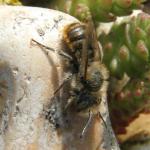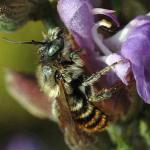Osmia tunensis aucct. partim (nec FABRICIUS 1787); Apis haematopoda PANZER 1801; Osmia marginella LEPELETIER 1841
A few British bees, all megachilines, habitually nest in empty snail shells; one of these is O. aurulenta (the others being O. bicolor and O. spinulosa)
Locally common in many coastal and inland localities in southern England. Apparently exclusively coastal in Wales, north-west England, south-west Scotland and Ireland. In the Channel Islands, it has be en recorded from Alderney, Guernsey, Herm, Jersey and Jethou (Richards, 1979); also Sark (Archer, 1996a). The species is widely distributed in central and southern Europe, its range extending from The Netherlands south to southern Iberia (including Mallorca), and east to Romania. Also recorded from North Africa.
A Nationally Notable (Nb) species (Falk 1991).
Coastal dunes, shingle ridges, grassland, landslips and abandoned quarries; inland on calcareous grassland and, rarely, clearings and rides in deciduous woodland on chalk.
Univoltine; April to early August.
Females of this species commonly build their nests in empty snail shells, including Helix aspersa, H. pomatia, Cepaea hortensis, C. nemoralis and Helicella itala. On the Devon coast, R C L Perkins (1891) reported the species nesting in whelk shells. On Hayling Island, South Hampshire, females have been observed inspecting empty Crepidula fornicata shells (G R Else, pers. obs.). The bee is also reported to nest in burrows in soil (Smith 1855). The nesting habits are described in detail by Maréchal (1926) and Else (1992). It seems that males seek out the snail shells; each bee establishing a territory around one, to which a female may be attracted (O'Toole & Raw, 1991).
In addition to the species listed above, the bees visit yellow horned-poppy (Glaucium flavum), violet (Viola sp), kidney vetch (Anthyllis vulneraria), horseshoe vetch (Hippocrepis comosa), bramble (Rubus fruticosus agg.), burnet rose (Rosa spinosissima), creeping willow (Salix repens), thrift (Armeria maritima), toadflax (Linaria sp.), ground-ivy (Glechoma hederacea), dandelion (Taraxacum officinale agg.) and an orchid (Orchidaceae).
Sapyga quinquepunctata has been reared from nests collected on Portland, Dorset (Else, 1992). Maréchal (1926) cites this wasp as a cleptoparasite of O. aurulenta and figures the Sapyga cocoon. The chalcid wasps Melittobia acasta and Pteromalus apum have been reported as parasitoids of O. aurulenta (Maréchal (1926) and Else (1992) respectively). The drosophilid fly Cacoxenus indigator and the bombyliid fly Villa modesta have also been reported from nests of this bee (O’Toole, 1978). The mite Chaetodactylus osmiae has been found in O. aurulenta nests (Else, 1992).
Profile written: 1998
Proofed: February 2012




